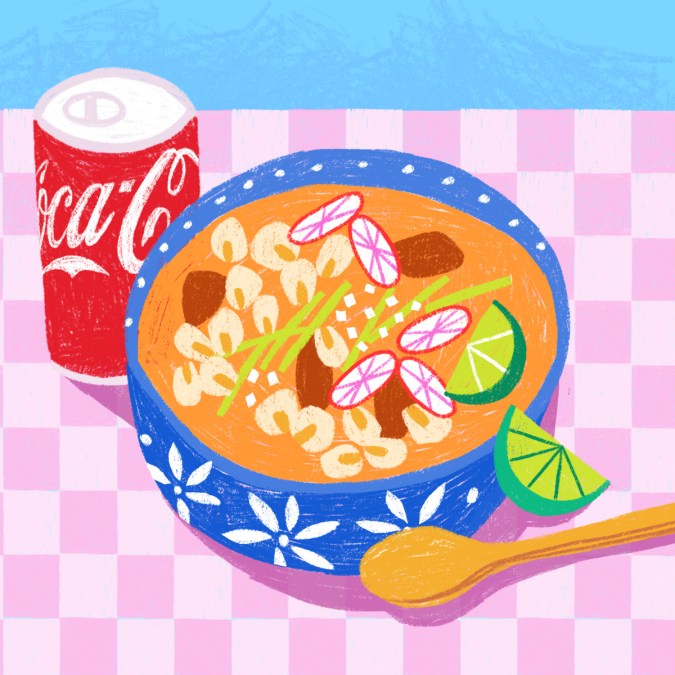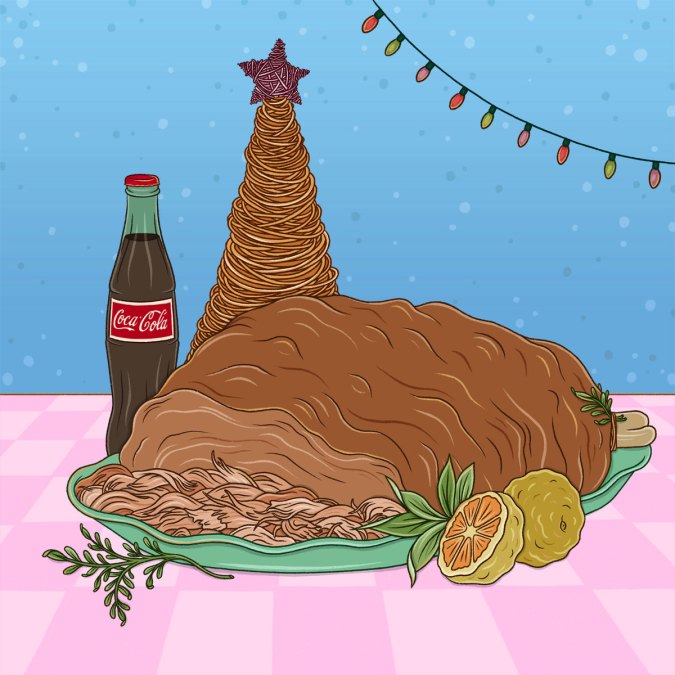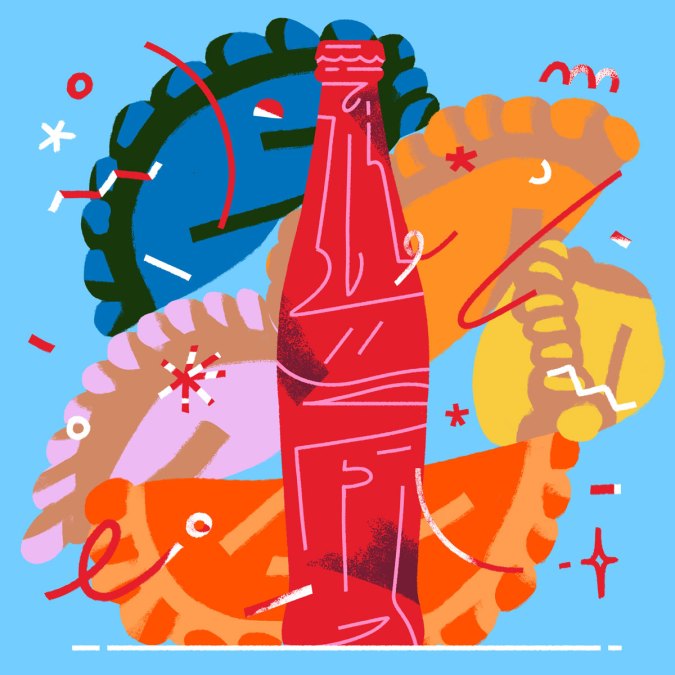In Spanish, the word “reunion” is used to mean “gathering.” For plenty of the Latin American diaspora, the end-of-year holidays mark opportunities to reunite and gather with friends and loved ones that are separated from them by many miles and international borders for most of the year. For these three U.S.-based Latine illustrators, Marisol Ortega,Gaby D’Alessandro and Sebastián Curi, holiday visits are long-awaited reunions with family members, friends, and culture — with food and a refreshing glass of Coca-Cola® at their center.
This 2021 holiday season, Remezcla and Coca-Cola® have teamed up to bring you a feast for the eyes — an illustrated potluck featuring these artists’ favorite holiday dishes. Potlucks are gatherings which celebrate community with intimacy and care through home-made food, and in this occasion, an opportunity to digitally highlight the Latine experience. From Mexican pozole to Dominican-style pierna de cerdo, and Argentine vitel tone, replete with story and a spoonful of nostalgia; get to know Marisol, Gaby, and Sebastián through the beloved and essential potluck dishes they bring to this cyber holiday celebration.
MARISOL ORTEGA brings her mom’s pozole — with all the toppings, and roots

For Marisol Ortega, a Mexican-American illustrator based out of Seattle, Washington — named one of 20 Latino Artists to Watch by Today —, Christmas is a bowl of pozole. Her mom, who visits from Michoacan, makes it for Marisol and her family, never using a recipe, instead relying on instincts and memories of her own mother cooking it before her. “My mom doesn’t measure recipes so I watch her eyeball it,” she tells Remezcla, explaining that it’s hard to get a recipe out of her.
“When we make it it’s me helping my mom, passing her ingredients — it ends up being a big girl talk. [Making pozole together is] a reconnecting sort of ritual, especially with Covid, we’ve had a lot more to share, talk, and think.”
Marisol says this is an important part of the holidays, because not only does it connect her to her roots and her mother, but connects four generations of women through this ancient soup — from her own grandmother, down to her daughter. “I’ve always been a big believer in sharing a meal with people,” she says. “It’s my love language.” And in this language of pozole, there are some must-have toppings she brings to the potluck. Including: diced white onion, sliced radish, cabbage and limes. Totopos (tortilla chips) and tostadas are common too. The non-negotiable for pozole? It’s become a running joke in Marisol’s family that no pozole is complete without a refreshing Coca-Cola® on the side to wash it all down. This part of her Christmas eve dinner tradition, along with mixing dishes and traditions from her English husband’s culture, is something that’s at the pinnacle of importance during the holiday dinner for Marisol. “For [my family and I] it’s been about how much of our traditions we can instill in our daughter — that means mixing plates from my husband’s family, and my mom’s [pozole and buñuelos]. I think it’s important to know where you came from.”
GABY D’ALESSANDRO brings her and her boyfriend’s pierna de cerdo, her uncle’s ponche, Coca-Cola® and gratitude

Gaby D’Alessandro, a Dominican illustrator based in Ridgewood, Queens, celebrates Christmas and New Years back home in the Dominican Republic. Her family reunites around a potluck-style dinner at a relative’s house for a warm festive feast with lots of music and dancing (though, you might not catch Gaby on the dance floor, she says). Gaby’s signature dish is a yucca mash, but to this potluck she brings a few other Dominican holiday staples: pierna de cerdo (roasted pork), pasteles en hoja, moro de gandules, lerenes, pastelitos, ponche and Coca-Cola®. Gaby and her boyfriend, Issac, bring the star dish: pierna de cerdo (roasted pork leg). She preps, making a bitter orange and garlic marinade for the pork to bathe in overnight, and he roasts it the next day— low and slow until the very end, blasting the heat on high to create a crispy exterior. Their pierna de cerdo has Gaby’s parent’s stamp of approval, who used to reproach Gaby for sneaking bites of its crispy skin as a kid. “No matter how full I got,” Gaby reminisces, “I always had room for the pork, particularly the cuerito, as we call the crispy skin. I frequently got scolded [as a kid] for pinching the pork and stealing bits of meat before dinner officially was served.”
To drink, the artist, whose work is inspired by nature and magical realism, also brings her uncle’s ponche — a Dominican eggnog which he sometimes flavors with plum or coconut. As well as Coca-Cola® — a staple in holiday dinners because of how well it pairs with savory dishes she says, which she’d drink out of a wine glass as a kid. Before getting ready to devour the spread, however, Gaby says they partake in a special Christmas tradition––a moment of gratitude.
“Everyone gets sentimental,” she shares. “Before we eat dinner we say a few words, express how grateful we are to have each other.”
SEBASTIÁN CURI brings his mom’s vitel tone, empanadas and quality time

Sebastián Curi, Los Angeles-based and Buenos Aires-born illustrator, grew up in Argentina with traveling parents, and coolly introduces himself as an “Argentinian guy.” His upbringing, much like his illustration work, reveals movement. This is also true of his home country, which he says is home to a lot of immigration — and it’s beautifully reflected in Argentine cuisine and traditions. To this holiday potluck, Sebastián brings a smorgasbord of dishes and traditions that echo this: vitel tone, ensalada Rusa (Russian potato salad), Sandwiches de Miga, empanadas and a cheese and salami board served with bread. Of course, an ice cold Coca-Cola® is always nearby, and especially refreshing during the heat of an Argentinian December. On the eve of the 24th, Sebastián is in Buenos Aires and says his family has a big dinner, and a long lunch with leftovers (or an asada — an Argentine barbeque) and cold-served dishes the day after on the 25th. “My mom will cook for a ton of people on the 24th. The next day [we eat] left-overs and she cooks more. She’s a good mom. She’s a momma bear.” His favorite holiday dinner dish by his mom is vitel tone, a dish with Italian origin that came about from smuggling tuna fish in northwest Italy in the 18th century. Vitel tone is veal slathered in a creamy anchovy or tuna-based sauce and freckles of capers— and though he loves it now, he didn’t feel this way as a teen. He credits his wife, Macarena, currently a textile designer and previously a cook, for opening up his palate.
Something he’s always loved, however, are empanadas. This is a dish that like sandwiches de miga (typically white bread cucumber sandwiches, but they can vary) and empanadas, are available all year and are typically store-bought since it’s often too hot to cook. But when they are homemade, he and his wife like to involve his family in the process, “it’s a fun dish to cook with the family,” he says. They lay out rounds of dough across the counter, and fill them with little diced squares of ham and cheese, or ground beef, olives, onions and pepper — empanadas are flexible this way — he says they can be as simple or sophisticated as you make them. The challenge is in the seal of the empanada, Sebastián says they don’t press the edges together with a fork, instead they do what is called a repulgue. Repulgue is a folding technique using your fingers, a skill that is typically passed down from generation to generation. “Some people are really good,” he says, “I’m average.” His family grills their empanadas (which can also be baked or fried) with coal or wood fires, giving them a little smokey char.
“I’m really into food, and I love to cook,” Sebastián reflects, “But at the end of the year, during Christmas especially, I’m really chill. Food is a side thing, I just want to see my family.”





